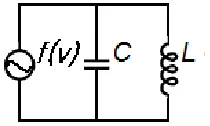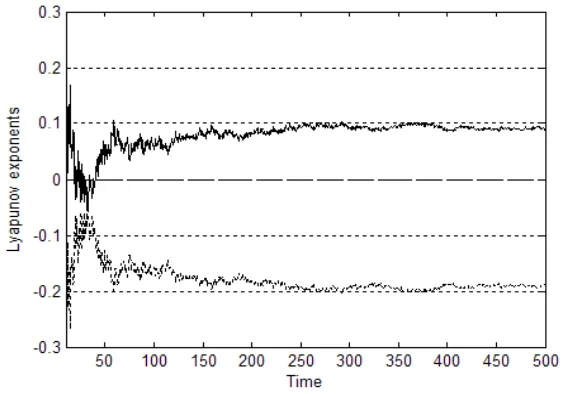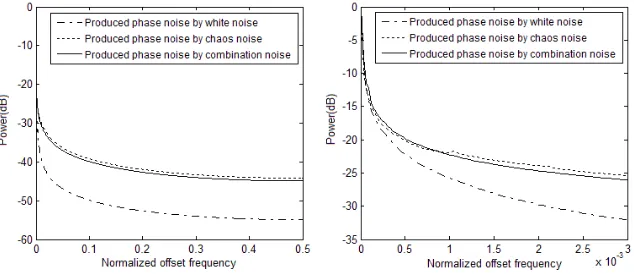Chaos on Phase Noise of Van Der Pol Oscillator
Gang Feng Yan, Xian He Huang
University of Electronic Science and Technology of China
No.4 Section 2, North Jian She Road, ChengDu, China 610054, Tel: +86-28-83202354 e-mail:[email protected]
Abstrak
Derau fasa adalah parameter paling penting dalam banyak osilator. Pada makalah ini, persamaan diferensial stokastik non-linear diusulkan untuk pendekatan analisis derau fasa. Selanjutnya diskusi dan perbandingan pengaruh dari dua sumber derau berbeda pada osilator Van Der Pol mengadopsi metode ini. Salah satu sumber derau adalah proses derau putih (white noise), yang mana adalah benar-benar proses stokastik, dan sumber derau lainnya adalah sistem deterministik sesungguhnya, yang menunjukkan perilaku khaotis di beberapa region. Perilaku osilator dalam kondisi yang berbeda diteliti secara numerik. Hasil penelitian menunjukkan bahwa derau fasa dari osilator lebih dipengaruhi oleh derau yang timbul dari khaotis daripada derau yang timbul dari proses stokastik asli pada intensitas derau yang sama.
Kata kunci: derau khaotis, derau fasa, osilator, persamaan diferensial non-linear stokastik
Abstract
Phase noise is the most important parameter in many oscillators. The proposed method in this paper is based on nonlinear stochastic differential equation for phase noise analysis approach. The influences of two different sources of noise in the Van Der Pol oscillator adopted this method are compared. The source of noise is a white noise process which is a genuinely stochastic process and the other is actually a deterministic system, which exhibits chaotic behavior in some regions. The behavior of the oscillator under different conditions is investigated numerically. It is shown that the phase noise of the oscillator is affected by a noise arising from chaos than a noise arising from the genuine stochastic process at the same noise intensity.
Keywords: chaos noise, oscillator, phase noise, stochastic nonlinear differential equation
1. Introduction
Phase noise and short term frequency stability are two representations of the same physical phenomenon. Short term frequency stability is a time domain description. Phase noise is a frequency domain description which describes stochastic fluctuation of oscillator phase. Phase noise is defined as the ratio of the single side-band power at a frequency offset of from the carrier with a measurement bandwidth of 1Hz to the carrier power. Signal contained phase noise is whether an emission excitation signal or local oscillation signal, noise will likewise appear in receiving end with signal. Thereby, Signal-to-noise ratio will be descended and error rate will be worsened as a result of the unwanted carrier modulation. So, it becomes increasingly important to research phase noise of oscillators.
use perspective of a state-space trajectory to analyze phase noise of oscillators. In their works, the noise causing perturbation is decomposed into two parts. One part causes a deviation in the state-space solution along the unperturbed trajectory, effectually altering the phase of the solution. The other part results in a deviation considered an orbital perturbation. The orbital perturbation can be shown to remain small given a small noise. And then analyze oscillator phase noise by a linearization of the oscillator equations around the noiseless periodic steady-state solution.
In fact, all of the previous approaches to oscillator phase noise analysis are based on some kind of explicit or implicit perturbation analysis, some linear and some nonlinear. However, oscillator system is essentially a nonlinear system. Any linearization method will change the essence of oscillator, so a new nonlinear stochastic analysis method is needed to analyze the phase noise without linearization operation. This paper directly describes oscillators by using nonlinear autonomous differential equation, and introduces noise signal as a term of nonlinear autonomous differential equation. Setting up nonlinear stochastic differential equation (NSDE) analyses phase noise of oscillators. And then adopt this method to compares the influence of two different sources of noise in the Van der Pol oscillator, one source of noise is a white noise process, which is a genuinely stochastic process; the other source of noise is actually a deterministic system, which exhibits chaotic behavior in some regions. The behavior of the oscillator under different conditions is investigated numerically. It is shown that the phase noise of the oscillator is affected more by noise arising from chaos than by noise arising from the genuine stochastic process at the same noise intensity.
2. Research Method
As any ideal oscillator has an output form as follows
)
2
cos(
00
π +
ϕ
=
A
ft
x
(1)where x is output of oscillator, A0 is amplitude of oscillator, f is output frequency of oscillator, φ0 is initial phase, A0, f and φ0 are all constant. Oscillators’ output is a signal spectral line in frequency domain at this case. Carefully observe equation (1), it must satisfy differential equation as follows
0 ) 2
( 2 =
+ • •
x f
x π (2)
Considering the nonlinear essence of oscillator, introduce nonlinear term εf(x,•x) to
describe nonlinear active device of oscillator. Without loss of generality, without noise, the oscillator is described by the scalar, ordinary differential equation
0 ) ,
( =
+
+ •
• •
x x f x
x ε (3)
where ε is a real number. The function f is nonlinear so ε is a parameter that controls the
degree of nonlinearity of the system. Introduced noise term, to describe oscillator with noise can be gotten the equation
) ( ) , (x x wt f
x
x+ + = • •
•
ε (4)
where w(t) is the noise.
3. Results and Analysis
it is not loss of generality to explain problem by using Van der Pol oscillator. Figure 1 shows a schematic of a Van der Pol oscillator.
Figure 1. Van der Pol oscillator
Considering the situation of no noise, described Figure 1 equation can be written
∫
+
=
+
1
vdt
f
(
v
)
0
L
dt
dv
C
(5)Let
∫
=
vdt
x
(6)[ ]
)
(
1
)
(
v
vdt
2v
R
v
f
=
−
−
∫
(7)Then, substituting the above expression into equation (5), it be obtained
0
)
(
1
1
2=
−
−
+
• •• •
x
x
x
RC
x
LC
x
(8)In order to gain numerical solution for equation (8), let LC=1,1/RC=0.1, the equation is
had
0
)
(
1
.
0
−
2=
−
+
• •• •
x
x
x
x
x
(9)Rewriting equation (9) as a system of equations, it is gotten
−
−
−
=
=
• •
x
y
x
y
y
x
)
1
(
1
.
0
2(10)
It exist only one equilibrium position (0,0), in this position, which has a pair of conjugate complex root with positive real part, so this equilibrium point is an unstable focal point. According to Lienard’s limit cycle theory [9], stable limit cycle exist in equation (9).
Introduced noise term w(t), the equation for described Van der Pol oscillator with noise is
)
(
)
(
1
.
0
x
x
2x
w
t
x
x
+
−
−
=
• • •
•
3.1. The output of Van der Pol oscillator without noise
Using four-order fix-step Runge-Kutta method to obtain numerical solution for equation (9), a stable periodic solution is gotten, whose phase diagram and solution is shown in Figure 2.
Figure 2. Phase diagram and solution of equation (9).
3.2. The output and phase noise of Van der Pol oscillator with chaos noise
In order to produce chaos noise, considering the situation of nonlinear differential equation actuated by periodic signal without loss of generality is
3
1
cos(
)
ni i
i
x
εδ
x x
x
ε
f
ω
t
⋅⋅ ⋅
=
+
+ −
=
∑
(12)Where
δ
is a damping coefficient,0< <<ε
1, n is number of periodic signal, fi isamplitude of periodic signal,
ω
i frequency of periodic signal.Rewriting equation (12) as a system of equations, it is gotten
3
1
( cos( ))
n
i i
i
x y
y x x
ε δ
y fω
t⋅
⋅
=
=
= − + + − +
∑
(13)
When
ε
=0, system (12) is Hamilton system, whose Hamilton quantity is2 2 4
1 1 1
( , )
2 2 4
H x y = y + x − x =const (14)
Due to
3
0
0
x
y
y
x
x
⋅
⋅
= =
= − + =
(15)
When const=0.25, there are two heteroclinic orbits to connect (1,0) with (-1,0), two parameter equation of heteroclinic orbits are
2
2
( ) ( )
2
2 2
( ) sec ( )
2 2
x t th t
y t h t
± ± = ± = ± (16)
The Melnikov function for equation (16) is
0 0
0 0
( )
(
i( ))
(
i( ),
)
M t
± ∞f q t
g q t t
t dt
−∞
=
∫
∧
+
(17)where 0 0 0 0 0
0 0 3
0 0 0 0 1
( )
( )
( )
( )
(
( ))
( ) [
( )]
0
(
( ),
)
( )
cos(
(
))
i i n i i i ix t
q t
y t
y t
f q t
x t
x t
g q t t
t
y t
f
t
t
δ
ω
± ± ± ± ± ± =
=
=
−
+
+
=
−
+
+
∑
So 0 0 0 0 1 4 2 0 1 0 1( )
[
( )
cos(
(
))]
( )
1
2
sec
(
)
2
2
2
2
[
sec
(
) cos(
)
]cos(
)
2
2
2 2
cos(
)
3
n i i i ni i i
i
n
i i i
i
M t
y t
f
t
t
y t dt
h
t dt
f
h
t
t dt
t
f I
t
δ
ω
δ
ω
ω
δ
ω
∞ ± −∞ ± ± = ∞ −∞ ∞ −∞ = ==
−
+
+
⋅
≈ −
±
±
= ±
±
∑
∫
∫
∑ ∫
∑
(18) where 2 22
2
sec
(
) cos(
)
2
2
2
2
[
sec
(
)
]
2
2
2
2
csc (
)
2
i
i i
i s
i i
I
h
t
t dt
e
h
s e
ds
h
ωω
πω
πω
∞ −∞ ∞ −∞=
= ℜ
=
∫
∫
So 0 0 12 2 2
( ) 2 csc ( ) cos( )
3 2
n
i i i i
i
M t±
δ
π
fω
hπω
ω
t=
According to Melnikov theory, when
δ
,
f
i,
ω
i value make existedt
0' to satisfy1) '
0
( ) 0
M t± =
2) ' ' 2 '
0 0
1
2
( ) 2 csc ( ) sin( ) 0
2
n
i i i i
i
M t±
π
fω
hπω
ω
t=
= ±
∑
≠System (12) produces chaos.
It is selected n=3, (fi, ωi)={(35,1),(40,4),(10,13)}, according to the conditions mentioned above, produced chaos noise is shown in Figure 3. Adopting algorithm proposed by Wolf [10] for produced chaos noise by equation (12), it is gotten two Lyapunov exponents are λ1= 0.089254, λ2= -0.189278 at t=500, whose time-evolvement curve is shown in Figure 4. By reason of maximal Lyapunov exponent greater than zero, it indicates that x’s values are determinately chaos data in Figure 3.
Figure 3. Phase diagram and solution of produced chaos noise by equation (12).
Figure 4. Time-evolvement curve of chaos noise Lyapunov exponents.
Figure 5. Phase diagram, solution and phase noise of Eqn (11) whose w(t) is chaos noise. (a) is phase diagram, (b) is x’s solution, (c) is phase noise
3.3. The output and phase noise of Van der Pol oscillator with white noise
Let w(t) is white noise in equation (11), setting its intensity is 0.01, obtained solutions by using stochastic Runge-Kutta method are shown in Fig. 6.
Figure 6. Phase diagram, solution and phase noise of equation (11) whose w(t) is white noise. (a) is phase diagram, (b) is x’s solution, (c) is phase noise
3.4. The output and phase noise of Van der Pol oscillator with combination noise
Let w(t) is combination noise in equation (11), i.e. white noise add chaos noise. Setting its variance is 0.01, obtained solutions by using stochastic Runge-Kutta method are shown in Figure 7.
Compared phase noise produce by white noise, chaos noise with combination noise in NSDE is shown in Figure 8.
Figure 8. Compared phase noise produce by white noise, chaos noise with combination noise in NSDE, (a) is compared phase noise within large offset frequency, (b) is compared
phase noise within small offset frequency.
4. Conclusion
By setting up NSDE to describe oscillator, it can be conveniently used numerical methods to analyses phase noise of oscillator system. Analyzing Fig. 8, it can be discovered that phase noise produced by chaos noise has a larger value than that of by white noise and very close to phase noise by combination noise under the same intensity conditions. This is due to pseudo-random of chaos noise. Because chaos noise is produced by deterministic system, amongst chaos noise has a long-larger correlative degree than that of white noise, which results in a small stochastic averaging of NSDE, so produces a large phase noise output. Because of universality of the chaos phenomena, chaos noise determinately exists in oscillator system. Therefore, in order to reduce phase noise in output of oscillator, it should be used the chaos control method to reduce chaos noise as great as possible by the time it is designed the oscillator. It is also an important research direction to use analytic methods to obtain analytic solution of NSDE in some sense for guiding minimized phase noise in an oscillator design.
References
[1] Edson WA. Noise in oscillators. Proc. of IRE. 1960; 48(8): 1454-1466.
[2] Mullen JA. Background Noise in Nonlinear Oscillators. Proc. of IRE. 1960; 8: 1467-1473. [3] Leeson DB. A Simple Model of Feedback Oscillator Noise Spectrum. Proc. of IEEE. 1966;
54(2): 329-330.
[4] Robins WP. Phase Noise in Signal Sources. London: Peter Peregrinus. 1982.
[5] Hajimiri A, Lee TH. Ageneral theory of phase noise in electrical oscillators. IEEE J Solid-State Circuits. 1998; 33(2): 179–194.
[6] Kaertner FX. Determination of the correlation spectrum of oscillators with low noise. IEEE Transactions on Microwave Theory and Techniques. 1989; 37(1): 90-101.
[7] Demir A. Fully Nonlinear Oscillator Noise Analysis: An Oscillator with no Asymptotic Phase. International Journal of Circuit Theory and Applications. 2007; 35(2): 175–203. [8] Demir A. Nonlinear Phase Noise in Optical Fiber Communication Systems. IEEE Journal of
Lightwave Technology. 2007; 25(8): 2002-2032.
[9] Liu SK, Liu SD. Nonlinear Equations in Physics. Beijing: Peking University Press. 2000. [10] Wolf A, Swift JB. Determining Lyapunov exponents from a time series. Physica D. 1985;
16(3): 285-317.




